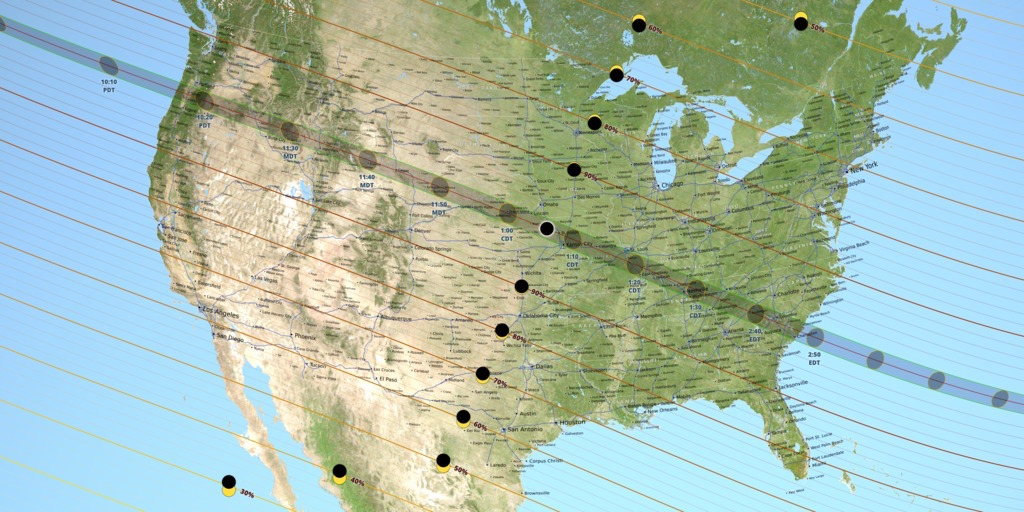Here's How to Watch the Great American Solar Eclipse Live
If you're not one of the 12 million people who live within the approximately 70-mile-wide (113 kilometers) path of totality, or one of the 1.85 million to 7.4 million people expected to travel to that path, there are still ways to watch the eclipse live. [Total Solar Eclipse 2017: Everything You Need to Know]
NASA will host two live streams: One will follow the eclipse across the U.S.; the other will broadcast from Carbondale, Illinois, a spot that will be in the path of totality for the 2017 eclipse and also the 2024 eclipse.
You can also check the Live Science website and follow @LiveScience on Twitter for photos and around-the-clock coverage of the total solar eclipse.
NASA's Eclipse Across America livestream will last from 12 p.m. to 4 p.m. EDT. This video will offer fantastic views from 12 locations, including from airplanes, ground telescopes and 57 high-altitude balloons.
To get another perspective, you can view NASA's Live from Carbondale livestream, which lasts from 11:45 a.m. to 4:15 p.m. EDT. Once you tune in, you will be able to watch live coverage of the eclipse, interviews with scientists, telescope feeds and educational activities; you can also participate in social media chats.
- Beach just north of Newport, Oregon: 10:15 a.m.
- Madras and Warm Springs, Oregon: 10:19 a.m.
- Stanley, Idaho: 11:28 a.m. MDT
- Mackay, Idaho: 11:30 a.m. MDT
- Weiser, Idaho: 11:25 a.m. MDT
- Grand Teton National Park, Wyoming: 11:35 a.m.
- Pavillion, Wyoming: 11:38 a.m.
- Alliance, Nebraska: 11:49 a.m.
- Lincoln, Nebraska: 1:02 p.m.
- Troy, Kansas: 1:05 p.m.
- Atchison, Kansas: 1:06 p.m.
- Kansas City, Missouri: 1:08 p.m.
- Murphysboro, Illinois: 1:19 p.m.
- Makanda, Illinois: 1:20 p.m.
- Carbondale, Illinois: 1:20 p.m.
- Marion, Illinois: 1:20 p.m.
- Paducah, Kentucky: 1:22 p.m.
- Franklin, Kentucky: 1:26 p.m.
- Clarksville, Tennessee: 1:25 p.m.
- Nashville, Tennessee (at the state capitol): 1:27 p.m.
- Clayton, Georgia: 2:35 p.m.
- Bryson City, North Carolina: 2:35 p.m.
- Murphy, North Carolina: 2:34 p.m.
- Greenville, South Carolina: 2:38 p.m.
- Charleston, South Carolina: 2:46 p.m.
And if you're curious about why the path of totality moves from west to east, how the unusual darkness will affect solar energy, how to explain the eclipse to kids or how ancient people viewed eclipses, we've got your back.
REMEMBER to never look directly at the sun during most of an eclipse, or at any other time, without proper protection. Only during the very brief period of totality are you safe to gaze at the sun with the naked eye, because the moon's shadow has completely blotted out the light. But at all other times, looking directly at the sun can harm your eyes. You must wear solar eclipse viewers; sunglasses won't do the trick. Here's a visual step-by-step guide (and a video) for how to make your own viewers.
Get the world’s most fascinating discoveries delivered straight to your inbox.
Original article on Live Science.

Laura is the managing editor at Live Science. She also runs the archaeology section and the Life's Little Mysteries series. Her work has appeared in The New York Times, Scholastic, Popular Science and Spectrum, a site on autism research. She has won multiple awards from the Society of Professional Journalists and the Washington Newspaper Publishers Association for her reporting at a weekly newspaper near Seattle. Laura holds a bachelor's degree in English literature and psychology from Washington University in St. Louis and a master's degree in science writing from NYU.



